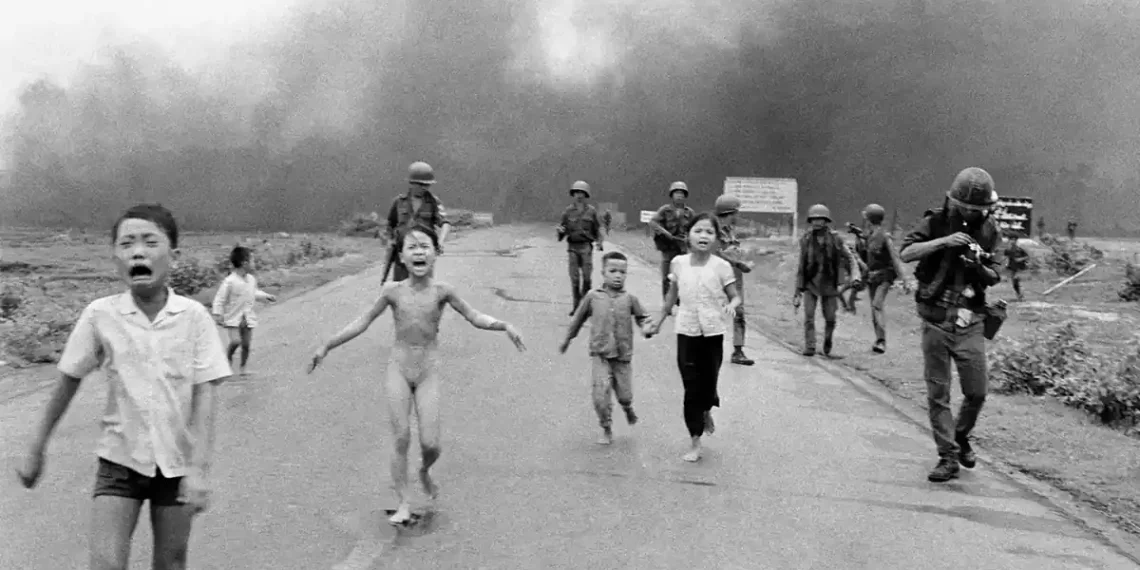Who Really Took the Iconic ‘Napalm Girl’ Photo? World Press Photo Suspends Attribution Amid Controversy
One of the most powerful images from the Vietnam War — the world-famous Napalm Girl photo — is at the center of a growing dispute. World Press Photo, which awarded the picture its 1973 “Photo of the Year,” has now suspended its official attribution to longtime Associated Press (AP) photographer Nick Ut, citing serious doubts about the photo’s true author.
The decision follows claims raised in The Stringer, a new documentary that premiered at Sundance, which argues that the image was actually captured by Nguyen Thanh Nghe, a Vietnamese freelancer. The film alleges Nghe took the photo and sold it to the AP before Ut was credited — a claim Ut and the AP strongly deny.
The Photo That Shook the World
Taken on June 8, 1972, the image shows a young, naked Phan Thi Kim Phuc fleeing a napalm attack near the village of Trang Bang. It quickly became a defining symbol of the horrors of the Vietnam War and later earned Ut a Pulitzer Prize.
But more than 50 years later, the photo’s authorship is being questioned in earnest.
Why the Doubt?
World Press Photo cited new technical analysis and visual studies that challenge Ut’s claim to the image. A reconstruction of the scene suggested that Ut would have had to take the shot, sprint nearly 60 meters, and return to help Kim Phuc in an extremely short time — a scenario the organization called “highly unlikely.”
At the heart of the debate is the type of camera used. While AP believed the photo was likely taken with a Pentax, which Nghe owned, Ut had long claimed he used Leica and Nikon cameras. Under new questioning, Ut acknowledged he may have used Pentax gear as well. AP later confirmed that some Vietnam-era negatives attributed to Ut match Pentax camera characteristics.
The investigation also raises the possibility that another photographer, Vietnamese military photojournalist Huynh Cong Phuc, could have taken the image.
AP and Nick Ut Push Back
In response, the AP conducted a 96-page internal review, including interviews, photo analysis, and a 3D model of the scene. Their conclusion? There’s no solid proof to change the original credit. The agency said the claims against Ut rely on speculation and that the evidence for Nghe’s authorship doesn’t hold up.
Ut himself, now retired and living in the U.S., has called the challenge “deplorable and unprofessional.” His legal team insists Nghe’s claim is entirely unsupported by witnesses or hard evidence.
“This whole thing has been very difficult for me and has caused great pain,” Ut said in a recent statement.
Pulitzer Stands By Its Award
Despite the debate, the Pulitzer Prize board has no plans to revisit Ut’s award. “The Pulitzer Prizes depend on submitting news organizations to determine the authorship of their entries,” said a spokesperson, emphasizing that AP’s own findings are key.
A Legacy Still Intact — For Now
The photograph remains one of the most iconic in history. The day after it was taken, it ran on front pages around the world and helped shift public opinion against the war.
Ut has spent years campaigning for peace alongside Kim Phuc, who miraculously survived her injuries and later moved to Canada. In 2022, to mark the image’s 50th anniversary, Ut recalled the moment he took the shot:
“I saw Kim running and she screamed ‘Too hot! Too hot!’ in Vietnamese. Her body was so badly burned. I put down my cameras and poured water on her, then rushed her to the hospital.”
As of now, World Press Photo has not reassigned authorship but maintains that there is too much uncertainty to continue crediting Ut outright. The suspension will stay in place unless conclusive evidence emerges in the future.
This article was rewritten by JournosNews.com based on verified reporting from trusted sources. The content has been independently reviewed, fact-checked, and edited for accuracy, neutrality, tone, and global readability in accordance with Google News and AdSense standards.
All opinions, quotes, or statements from contributors, experts, or sourced organizations do not necessarily reflect the views of JournosNews.com. JournosNews.com maintains full editorial independence from any external funders, sponsors, or organizations.
Stay informed with JournosNews.com — your trusted source for verified global reporting and in-depth analysis. Follow us on Google News, BlueSky, and X for real-time updates.














